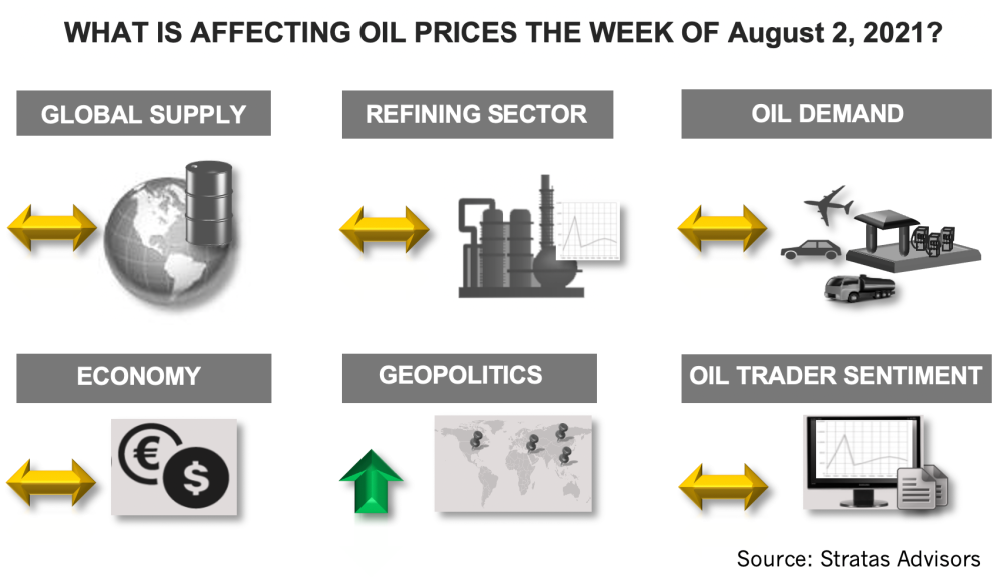
Additionally, Stratas Advisors says it is expecting a return of some restrictions on travel and economic activity due to rising COVID-19 cases, but no lockdowns that would have a material impact on the firm’s oil demand forecast. (Source: Collage by Hart Energy; images from Hart Energy and Shutterstock.com)
[Editor’s note: This report is an excerpt from the Stratas Advisors weekly Short-Term Outlook service analysis, which covers a period of eight quarters and provides monthly forecasts for crude oil, natural gas, NGL, refined products, base petrochemicals and biofuels.]
The price of Brent crude ended the week at $75.22 after closing the previous week at $74.19. The price of WTI crude ended the week at $73.62 after closing the previous week of $72.07. The price movement of the last months has aligned closely with our forecasts, including our forecast for the third quarter, which was updated in June of this year—and includes the following:
Brent crude
- July—forecasted price of $73.12
- August—forecasted price of $75.08
- September—forecasted price of $75.86
WTI crude
- July—forecasted price of $69.75
- August—forecasted price of $71.67
- September—forecasted price of $72.23
Looking forward to the fourth quarter, our latest forecast is calling for Brent crude oil averaging a little more than $76 and for WTI averaging between $72 and $73.
We have done some further analysis of the COVID-19 data associated with bellwether countries (covered under the economic section of this note), and the current data and trends indicate that the vaccines have significantly reduced deaths and to a lesser degree, hospitalizations. However, the vaccines do not appear to be nearly as effective in reducing the spread of the virus—at least in its milder form. Additionally, it seems that the effectiveness of the vaccines wane over time, which translates into the need for boosters. Therefore, we are expecting a return of some restrictions on travel and economic activity, but no lockdowns that would have a material impact on our demand forecast. However, at this time, the risk is to the downside with COVID-19 mitigated somewhat, but not under control—nor on the verge of being stamped out.
With the OPEC+ agreement in place, U.S. production will be a key variable that will affect the future supply/demand dynamics and oil prices. Our current forecast for the U.S. for the rest of the year is shown below:
- Third-quarter production will increase on average by 290,000 bbl/d from the second quarter
- Fourth-quarter production will increase on average by 50,000 bbl/d from the third quarter—and will average 1.5 million bbl/d less than in the fourth quarter of 2019
The forecast is supported by the well-level assessment undertaken by our upstream team. For example, the upstream team just completed an assessment of the Wolfcamp play in the Delaware Basin, which is located in New Mexico and Texas. The assessment indicates that production will average 1.60 million bbl/d in the third quarter and then increase to 1.7 million bbl/d in the fourth quarter. In comparison, during March 2020 (just before the onset of COVID-19 in the U.S. and the collapse of the oil price) production was at 1.9 million bbl/d.

About the Author:
John E. Paise, president of Stratas Advisors, is responsible for managing the research and consulting business worldwide. Prior to joining Stratas Advisors, Paisie was a partner with PFC Energy, a strategic consultancy based in Washington, D.C., where he led a global practice focused on helping clients (including IOCs, NOC, independent oil companies and governments) to understand the future market environment and competitive landscape, set an appropriate strategic direction and implement strategic initiatives. He worked more than eight years with IBM Consulting (formerly PriceWaterhouseCoopers, PwC Consulting) as an associate partner in the strategic change practice focused on the energy sector while residing in Houston, Singapore, Beijing and London.
Recommended Reading
Halliburton’s Low-key M&A Strategy Remains Unchanged
2024-04-23 - Halliburton CEO Jeff Miller says expected organic growth generates more shareholder value than following consolidation trends, such as chief rival SLB’s plans to buy ChampionX.
Deepwater Roundup 2024: Americas
2024-04-23 - The final part of Hart Energy E&P’s Deepwater Roundup focuses on projects coming online in the Americas from 2023 until the end of the decade.
Ohio Utica’s Ascent Resources Credit Rep Rises on Production, Cash Flow
2024-04-23 - Ascent Resources received a positive outlook from Fitch Ratings as the company has grown into Ohio’s No. 1 gas and No. 2 Utica oil producer, according to state data.
E&P Highlights: April 22, 2024
2024-04-22 - Here’s a roundup of the latest E&P headlines, including a standardization MoU and new contract awards.
Technip Energies Wins Marsa LNG Contract
2024-04-22 - Technip Energies contract, which will will cover the EPC of a natural gas liquefaction train for TotalEnergies, is valued between $532 million and $1.1 billion.





